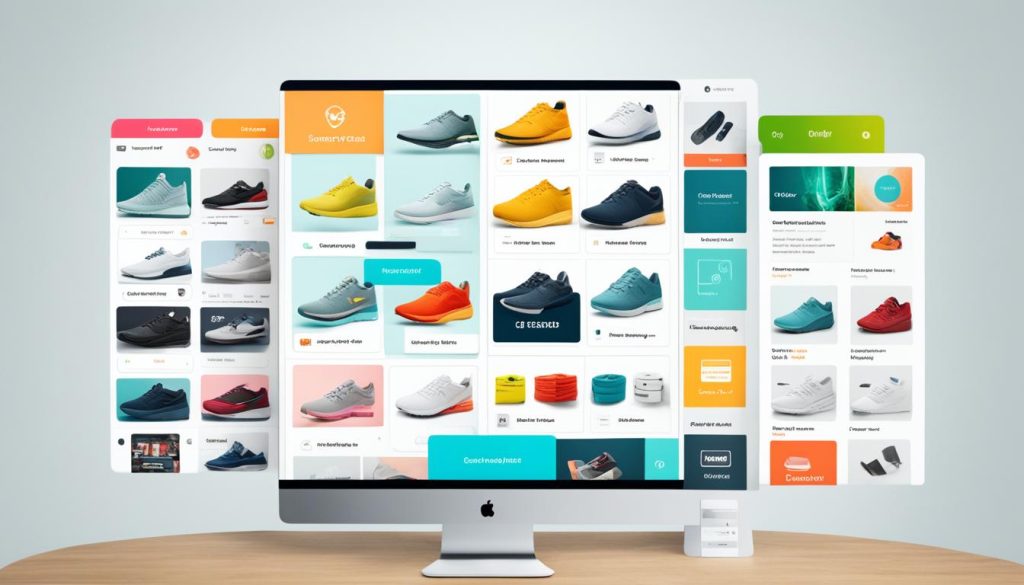The global digital products market hit $1.3 trillion in 2022 and is set to reach $2.1 trillion by 2027. This growth offers a huge chance for entrepreneurs to sell digital products online. It’s a great time to join the trend and make money from your blog.
If you’re into digital marketing, content creation, or want to earn passive income, you’re in the right place. There are many platforms to sell digital products on your blog. This guide will show you the best options to help you start making money from your blog through digital sales and affiliate marketing.
Introduction to Selling Digital Products
In today’s e-commerce world, digital products are changing the game. They let entrepreneurs and creators make money easily and start a digital business. These products are like magic items you can’t touch but are sold online a lot.
What are Digital Products?
Digital products are things you can’t hold in your hand but can sell online many times. They range from Canva templates to online courses and printable artwork. The best part is, you can make lots of them without spending a lot of money or time.
Benefits of Selling Digital Products
Selling digital products has many perks. It’s a great way to make money without much work. You don’t have to worry about storing things or making more of them. This lets you focus on making great products and keeping customers happy.
| Benefit | Description |
|---|---|
| Passive Income | Digital products can make money even when you’re not working, giving you a steady income. |
| Lower Overhead | They don’t need storage or making, so you save money and make more profit. |
| Scalability | You can sell the same product over and over, growing your business fast. |
Digital products open up many chances to make money and grow your online business. They’re perfect for both new and experienced creators. The digital world is full of chances to make your business thrive.
Importance of Choosing the Right Platform
Choosing the right platform to sell digital products is crucial for success. The right platform offers tools, features, and exposure to market your products and boost sales. On the other hand, the wrong platform can limit your reach and hinder your sales efforts.
When picking a platform, think about your business goals, who you want to reach, and what features you need. Whether you choose an e-commerce platform, a marketplace platform, or your own online store, your choice affects your sales and marketing strategy.
The platform you pick impacts your product pricing, how you find customers, and your control over your brand and sales. It’s important to consider the pros and cons of each option. This ensures you pick a platform that fits your vision for your digital product business and your sales and marketing goals.
| Platform Type | Advantages | Disadvantages |
|---|---|---|
| E-commerce Platforms |
|
|
| Marketplace Platforms |
|
|
| Your Own Website |
|
|
By carefully evaluating the different digital product platform options, you can choose the best one for your business. This ensures your digital products succeed and your sales and marketing efforts match your goals.
Factors to Consider When Selecting a Platform
Choosing a platform to sell your digital products is key. Think about your target audience and niche focus. Sites like Gumroad, Etsy, and Udemy connect you with a big customer base. But, you must market your products well to stand out.
Platforms like Shopify and Podia let you have your own store. This gives you more control over branding and customer experience. But, you’ll work harder to get traffic and sales.
The pricing and fees of the platform matter too. Marketplaces often take big fees and transaction fees, cutting into your profits. Making your own website or using a single-product checkout page can save you money.
The features and customization options of the platform are important for success. Gumroad and Etsy have fewer options because they have their own brand rules. Shopify and Podia let you design your store and customize the customer experience. But, they need more time and effort to set up and keep running.

Sell Digital Products on Marketplace Platforms
If you want to sell digital products, consider using platforms like [Gumroad](https://www.thinkific.com/blog/best-marketplace-sell-digital-products/), Etsy, and Udemy. These sites give you a big customer base right away. This is great for new sellers. They also make it easy to start selling, unlike making your own website.
Benefits of Marketplace Platforms
- Access to a wide, existing customer base
- Quick and easy setup process
- Handling of payment processing and tax responsibilities
Drawbacks of Marketplace Platforms
Marketplace platforms have their pros and cons. A big con is the high fees and percentages they take from your sales. Also, you’ll find limited customization options. And, you can’t really market or talk directly to your customers, since the platform owns the relationship with them.
| Benefit | Drawback |
|---|---|
| Access to existing customer base | High fees and commissions |
| Quick and easy setup | Limited customization options |
| Handling of payment and taxes | Lack of customer ownership |
When choosing to sell on a marketplace platform, think about the good and bad points. This will help you see if it’s right for your business and goals.

Sell Digital Products on E-Commerce Platforms
E-commerce platforms like Shopify and Sellfy are great for selling digital products. They let sellers create their own online stores. This gives them more control over their brand and how customers experience their products. These platforms are flexible.
Advantages of E-Commerce Platforms
You can sell many digital products on these platforms, like ebooks, courses, and software. They make it easy to change prices and run promotions. This lets you try different ways to make more money.
These platforms also work with many payment systems and marketing tools. This makes selling easier and helps you reach more people.
They focus a lot on branding. You can make your online store look just how you want. This helps you build a strong brand and keep customers coming back.
Also, these platforms let you connect your products with other tools. This includes email marketing, CRM systems, and analytics tools. This makes it easier to track and improve your business.

| Feature | Benefit |
|---|---|
| Customizable Online Store | Strengthens your brand and provides a unique customer experience |
| Flexible Pricing and Promotions | Allows you to experiment and optimize your pricing strategies |
| Integrations with Third-Party Tools | Streamlines your sales and marketing efforts, improves data tracking and analysis |
Sell Digital Products on Your Own Website
Many entrepreneurs prefer to sell digital products on their own site. This choice offers big benefits like more branding control, pricing flexibility, and ownership of customer data. By doing this, you can shape the whole customer experience and keep a close bond with your audience.
Pros of Selling on Your Own Website
- Branding control: You can design your digital products to match your brand perfectly. This ensures they look and feel just right.
- Pricing flexibility: You set your own prices, free from the fees of other platforms.
- Customer data ownership: You keep all customer data and insights. This helps improve your marketing and connect better with your audience.
- Higher profit margins: With control over fees and costs, you can make more money than on other platforms.
Cons of Selling on Your Own Website
Selling digital products on your own site has its downsides too:
- Website setup and maintenance: You must put time and effort into creating and keeping a good-looking, safe website.
- Traffic generation: Getting people to your site and turning them into buyers takes a lot of SEO, advertising, and marketing efforts.
- Responsibility for customer service: You handle all customer support, which can be a big job and need more resources.
Choosing to sell on your own site or a third-party platform depends on your goals, resources, and who you want to reach. Think about the good and bad sides to pick the best way for your business.

Sell Digital Products with a Single Product Checkout Page
Using a single-page checkout for digital products makes shopping easy and straightforward for customers. It cuts down on steps and makes buying simple. This leads to fewer abandonments. You can also put your products in front of people easily, like in emails, on social media, blogs, and websites.
Benefits of Single Product Checkout Pages
- Streamlined Checkout Process: A single-page checkout means customers don’t have to go through many steps. This lowers the chance of them giving up and makes buying easier.
- Increased Conversion Rates: Making buying simple can lead to more people completing their purchases. Customers are more likely to finish what they started.
- Reduced Abandonment: A simple checkout helps cut down on abandoned carts. Customers aren’t sidetracked by other products or options.
- Flexible Placement: You can put your checkout links or pages almost anywhere. This includes your site, social media, or emails, making it easy to reach your audience.

With a single-page checkout, you make buying from you smooth and easy. This can help you sell more and reduce abandoned carts. It’s a great way to sell your digital products on different platforms.
Sell digital products on blog
Selling digital products on your blog is a great way to make money and earn passive income. You can use your blog to sell products that fit your niche and what you know a lot about. This way, you keep control over how customers experience your products and the money they make from them.
One big plus of selling digital products on blog is making buying easy and personal for your readers. Your blog is already a place where people come for your content. Adding a digital product store makes it easy for them to buy what you offer.
Blog monetization through selling digital products can help you earn more money without much work. After you make and share your digital products, you can keep making money with little effort. This lets you focus on making more great content for your readers.
To sell digital products on your blog well, think about these tips:
- Find digital products that match your blog’s theme and what your readers want
- Add a digital product store or checkout page to your blog easily
- Advertise your products on your blog, in emails, and on social media
- Make your product descriptions, prices, and sales process better to get more sales
- Keep asking your readers what they think and improve your products based on their feedback
Using your blog to sell digital products helps you make more money, build your brand, and connect more with your audience. It also gives you a steady passive income source.
Comparison of Top Platforms for Selling Digital Products
Choosing the right platform to sell your digital products is crucial. It depends on your needs, who you want to reach, and what you’re selling.
Marketplace platforms like Gumroad, Etsy, and Udemy connect you with many customers. But, they charge more and give you fewer ways to brand your products. E-commerce platforms such as Shopify and Sellfy let you control your brand and customer experience. Yet, you’ll need to work harder to get people to visit and buy from your site.
Single product checkout page solutions make buying easy and let you place your product anywhere. But, they don’t offer as many ways to customize as other options.
| Platform Type | Pros | Cons |
|---|---|---|
| Marketplace Platforms |
|
|
| E-Commerce Platforms |
|
|
| Single Product Checkout |
|
|
The best platform for your digital products depends on what you need and want. Look at each platform’s features, fees, and audience to find the best fit for your business.
Best Marketplaces for Selling Digital Products
There are many marketplaces where you can sell digital products. Three are great for creators wanting to make money from their work:
Gumroad
Gumroad is a top choice for selling digital items directly to your fans. It’s easy to use and lets you sell things like e-books, music, and software. You can also use tools like pre-orders and upselling to grow your sales.
Etsy
Etsy is known for its unique, handmade, and vintage items. It’s perfect for artists and makers to sell their work. The community on Etsy helps sellers and buyers connect, supporting small businesses.
Udemy
Udemy is a big site for learning with lots of courses on different topics. Teachers can sell their courses here, reaching many students. It’s a place for sharing knowledge and growing skills.
Best E-Commerce Platforms for Selling Digital Products
If you’re an entrepreneur looking to sell digital products like ebooks, graphics, or software, picking the right e-commerce platform is key. Shopify and Sellfy are top choices for creators and small businesses.
Shopify: Customizable E-Commerce Power
Shopify is a versatile e-commerce platform that lets sellers create their own online stores. It gives users the tools to design and manage their unique e-commerce websites. They can show off their brands, products, and stories. Shopify has lots of features like full branding control, customizable designs, and payment gateway integrations. This makes it great for selling digital products.
Sellfy: Flexible Digital Product Sales
Sellfy is another e-commerce platform for selling digital products. Like Shopify, it lets sellers customize their stores, set prices, and run promotions. It also works with payment gateways and marketing tools. Sellfy is perfect for entrepreneurs and creators who want to sell various digital products directly to customers. It offers a simple and easy-to-use experience.
| Platform | Strengths | Weaknesses |
|---|---|---|
| Shopify |
|
|
| Sellfy |
|
|
Choosing between Shopify and Sellfy depends on your business needs. Both platforms offer strong solutions for selling digital products online. They have their own strengths and things to consider.
Best Platforms for Creating Your Own Store
For creators and entrepreneurs wanting to sell digital products directly, two platforms are top picks: Podia and WordPress with WooCommerce.
Podia: Empowering Creators with Customizable Digital Storefronts
Podia is a top e-commerce platform for digital creators. It has a simple interface and lets you customize your website. You can sell online courses, memberships, and downloads easily. Podia’s tools make selling digital products smooth, so you can focus on connecting with your audience and growing your business.
WordPress with WooCommerce: Flexible and Customizable E-Commerce
WordPress with WooCommerce is great for a custom e-commerce platform. It lets you design your store and manage your products in the WordPress system. This combo is flexible and lets you integrate many third-party tools. It helps you create a unique e-commerce experience for your digital product sales.
Choosing Podia or WordPress with WooCommerce gives you a strong way to sell your digital products online. Both have easy interfaces and powerful features. They offer the tools you need to build a successful e-commerce business and reach your audience.
Best Single Product Checkout Page Solutions
Using a single-page, single-product checkout can make buying digital products easy and straightforward. It cuts out extra steps, making it simpler for customers to buy. This leads to fewer people leaving their purchases behind. With tools like Checkout Page, you can show your products anywhere you meet your audience, like in emails, on social media, blogs, or websites.
These checkout pages are made to make buying smoother, cutting down on hassle and boosting sales. You can easily add your digital products and make the page look like your brand. This creates a checkout experience that keeps customers interested and ready to buy.
By making checkout easier, you give your customers a better experience and help prevent them from leaving their carts. Single product checkout pages mean no more going back and forth. This keeps customers focused on what they want to buy. It helps you sell more and makes customers happier with their purchase.

